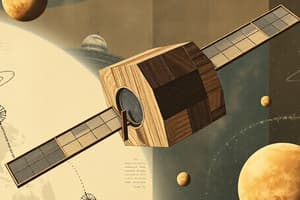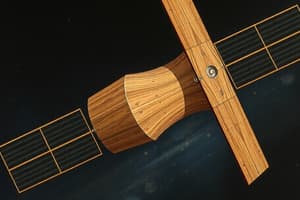Podcast
Questions and Answers
What is the primary environmental concern that LignoSat aims to address by using wood instead of aluminum in satellite construction?
What is the primary environmental concern that LignoSat aims to address by using wood instead of aluminum in satellite construction?
- The potential for wooden satellites to disrupt Earth's magnetic field, leading to communication failures.
- The release of harmful aluminum oxide particles into the atmosphere during satellite reentry, which could damage the ozone layer. (correct)
- The increased risk of collisions with other space debris due to the lighter weight of wooden satellites.
- The depletion of hardwood forests on Earth to supply wood for satellite construction, leading to deforestation.
Considering the objectives of the LignoSat project, what is the most significant implication of successfully proving that wood can withstand the harsh conditions of space?
Considering the objectives of the LignoSat project, what is the most significant implication of successfully proving that wood can withstand the harsh conditions of space?
- It would allow for the immediate replacement of all existing satellites with wooden versions, significantly reducing space debris.
- It would enable the construction of larger and more complex satellites, increasing the amount of data that can be collected from space.
- It would lead to a decrease in funding for research into alternative materials for spacecraft construction.
- It would pave the way for the development of habitats and infrastructure on other planets using locally grown timber. (correct)
How might the use of wood in satellites contribute to a more sustainable approach to space exploration, considering the life cycle of a satellite?
How might the use of wood in satellites contribute to a more sustainable approach to space exploration, considering the life cycle of a satellite?
- By ensuring that satellites last longer in orbit, reducing the frequency of new launches.
- By utilizing a material that produces less harmful byproducts upon reentry into Earth's atmosphere. (correct)
- By making satellites easier to track and recover after their mission is complete.
- By increasing the satellite's ability to collect solar energy, reducing its reliance on batteries.
What was the purpose of sending wood samples to the ISS prior to the LignoSat launch, and how did this preliminary testing influence the design of the satellite?
What was the purpose of sending wood samples to the ISS prior to the LignoSat launch, and how did this preliminary testing influence the design of the satellite?
Considering the perspective of Professor Koji Murata, why might the LignoSat project be seen as a challenge to conventional engineering wisdom?
Considering the perspective of Professor Koji Murata, why might the LignoSat project be seen as a challenge to conventional engineering wisdom?
How does the potential use of timber in space align with long-term visions for space exploration and habitation, as suggested by Takao Doi?
How does the potential use of timber in space align with long-term visions for space exploration and habitation, as suggested by Takao Doi?
Assuming LignoSat's mission is successful, how might the data gathered during its six-month orbit influence the design and construction of future spacecraft?
Assuming LignoSat's mission is successful, how might the data gathered during its six-month orbit influence the design and construction of future spacecraft?
Considering the broader implications of the LignoSat project, how could it contribute to a shift in the public's perception of space exploration and technology?
Considering the broader implications of the LignoSat project, how could it contribute to a shift in the public's perception of space exploration and technology?
If the use of wooden satellites becomes widespread, what potential economic impacts could this have on industries related to space technology and resource management?
If the use of wooden satellites becomes widespread, what potential economic impacts could this have on industries related to space technology and resource management?
Considering the need for long-term space missions and the establishment of off-world colonies, what advantages might wood offer over other materials in terms of resource availability and self-sufficiency?
Considering the need for long-term space missions and the establishment of off-world colonies, what advantages might wood offer over other materials in terms of resource availability and self-sufficiency?
Flashcards
LignoSat
LignoSat
World's first satellite made mostly from wood, designed to test wood's durability in space.
LignoSat Space Wood Project
LignoSat Space Wood Project
Project by Kyoto University and Sumitomo Forestry to explore wood's potential in space.
Environmental Impact of Aluminum Satellites
Environmental Impact of Aluminum Satellites
The effect of burning aluminum satellites that release aluminum oxide particles, potentially harming the ozone layer.
Reducing Space Junk Impact
Reducing Space Junk Impact
Signup and view all the flashcards
Space Colonization with Timber
Space Colonization with Timber
Signup and view all the flashcards
Study Notes
- LignoSat reached the International Space Station (ISS) aboard a SpaceX cargo capsule on November 5, 2024.
- LignoSat is the world’s first satellite made mostly from wood.
- It will be launched from the ISS into Earth’s orbit later in December 2024.
- LignoSat will determine if wood can withstand the harsh conditions of space.
- A successful mission could lead to more environmentally friendly spacecraft designs..
- The satellite is named after the Latin word for “wood".
- LignoSat is a palm-sized satellite.
LignoSat Space Wood Project
- This is a collaboration between Japan's Kyoto University and Sumitomo Forestry.
- Researchers sent a panel with three different wood samples to the ISS in 2022.
- The panel was exposed to space for ten months.
- It was returned to Earth in early 2023.
- Wood from magnolia trees was chosen for the satellite after analyzing the results.
- Professor Koji Murata of Kyoto University said no one had ever considered using wood for rocket science.
Space Junk Reduction
- Testing a wooden satellite can reduce space junk.
- Current satellites are primarily made of aluminum.
- Aluminum reacts with oxygen during atmospheric reentry, releasing aluminum oxide particles.
- Aluminum oxide particles potentially damage the ozone layer.
- Wooden satellites leave behind only water and carbon dioxide.
- Takao Doi, an aerospace engineer with Kyoto University, explained that alumina particles from burning satellites float in the upper atmosphere for many years, eventually affecting Earth's environment.
Future Applications
- Researchers envision growing trees on the Moon and Mars.
- Successfully testing a wooden satellite would prove wood can withstand harsh space conditions.
- Doi believes timber, a self-producible material, could enable building houses and living/working in space indefinitely.
- LignoSat will orbit Earth for six months.
- It will gather data before burning up in the atmosphere.
- Murata's team plans to use this data to design larger, more advanced wooden satellites and devices.
Studying That Suits You
Use AI to generate personalized quizzes and flashcards to suit your learning preferences.





